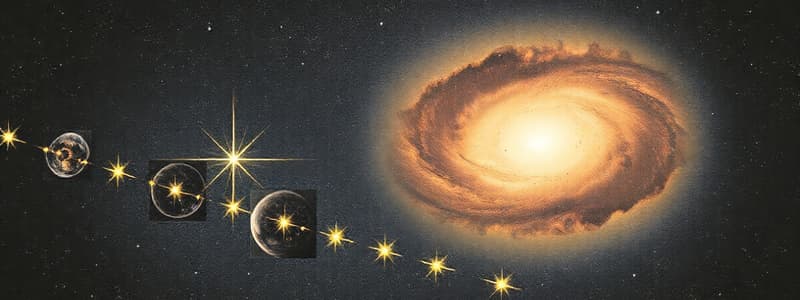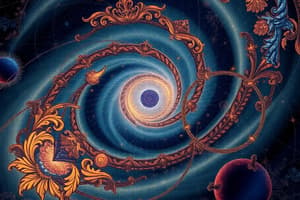Podcast
Questions and Answers
What distinguishes a spiral galaxy from an elliptical galaxy?
What distinguishes a spiral galaxy from an elliptical galaxy?
- Elliptical galaxies contain more interstellar gas and dust.
- Spiral galaxies have a prominent disc component. (correct)
- Spiral galaxies are always smaller in size.
- Spiral galaxies are formed from mergers of smaller galaxies.
Which process primarily leads to the formation of a spiral galaxy?
Which process primarily leads to the formation of a spiral galaxy?
- The collapse of a protogalactic gas cloud. (correct)
- The merger of two large elliptical galaxies.
- The gravitational collapse of individual stars.
- The evaporation of gas clouds in space.
What is a key feature of barred spiral galaxies?
What is a key feature of barred spiral galaxies?
- They are composed entirely of older star populations.
- They lack a central bulge.
- Their spiral arms do not originate from a bar.
- They contain extra star formation regions within the bar. (correct)
Which of the following statements is true regarding the morphology of galaxies?
Which of the following statements is true regarding the morphology of galaxies?
What primarily characterizes giant elliptical galaxies compared to dwarf elliptical galaxies?
What primarily characterizes giant elliptical galaxies compared to dwarf elliptical galaxies?
What causes the spheroidal shape of elliptical galaxies?
What causes the spheroidal shape of elliptical galaxies?
Who originally conceived the classification scheme for galaxy morphology?
Who originally conceived the classification scheme for galaxy morphology?
Which of the following is NOT a characteristic of spiral galaxies?
Which of the following is NOT a characteristic of spiral galaxies?
What did Fritz Zwicky observe that implied the existence of unseen matter?
What did Fritz Zwicky observe that implied the existence of unseen matter?
During galaxy cluster collisions, which component does not collide due to being diffuse?
During galaxy cluster collisions, which component does not collide due to being diffuse?
What evidence suggests the existence of dark matter during galaxy cluster collisions?
What evidence suggests the existence of dark matter during galaxy cluster collisions?
How are mass maps of galaxy clusters inferred?
How are mass maps of galaxy clusters inferred?
What drives the growth of galaxies according to the information provided?
What drives the growth of galaxies according to the information provided?
What types of gases formed the first stars according to the content?
What types of gases formed the first stars according to the content?
Which statement accurately reflects the growth of dark matter halos over time?
Which statement accurately reflects the growth of dark matter halos over time?
At what redshift did the first stars form in relation to the Big Bang?
At what redshift did the first stars form in relation to the Big Bang?
What evidence suggests the presence of dark matter in the Milky Way?
What evidence suggests the presence of dark matter in the Milky Way?
How does dark matter affect the formation of galaxies?
How does dark matter affect the formation of galaxies?
What characterizes the size and mass of galaxy clusters?
What characterizes the size and mass of galaxy clusters?
What happens to the velocity of galaxies in more massive galaxy clusters?
What happens to the velocity of galaxies in more massive galaxy clusters?
What is a major characteristic of dark matter?
What is a major characteristic of dark matter?
Why are galaxy clusters gravitationally bound?
Why are galaxy clusters gravitationally bound?
How is the mass of a galaxy cluster estimated?
How is the mass of a galaxy cluster estimated?
What prevents galaxy clusters from growing larger?
What prevents galaxy clusters from growing larger?
Flashcards
Galaxy Morphology
Galaxy Morphology
Different shapes of galaxies, ranging from bulge-dominated (elliptical) to disc-dominated (spiral), and sometimes barred spiral.
Spiral Galaxy Formation
Spiral Galaxy Formation
Forms from the collapse of a rotating protogalactic gas cloud, growing through gas infall into the dark matter halo.
Elliptical Galaxy Formation
Elliptical Galaxy Formation
Forms from mergers of multiple galaxies, leading to a scrambled, spheroidal shape.
Spiral Galaxy Morphology
Spiral Galaxy Morphology
Signup and view all the flashcards
Elliptical Galaxy Morphology
Elliptical Galaxy Morphology
Signup and view all the flashcards
Protogalactic Gas Cloud
Protogalactic Gas Cloud
Signup and view all the flashcards
Dark Matter Halo
Dark Matter Halo
Signup and view all the flashcards
Galaxy Merger
Galaxy Merger
Signup and view all the flashcards
Dark Matter Evidence (Milky Way)
Dark Matter Evidence (Milky Way)
Signup and view all the flashcards
Dark Matter Nature
Dark Matter Nature
Signup and view all the flashcards
Dark Matter Location (Milky Way)
Dark Matter Location (Milky Way)
Signup and view all the flashcards
Galaxy Clusters
Galaxy Clusters
Signup and view all the flashcards
Cluster Mass Estimation
Cluster Mass Estimation
Signup and view all the flashcards
Galaxy Cluster Growth Limit
Galaxy Cluster Growth Limit
Signup and view all the flashcards
Galaxy Cluster Gravity
Galaxy Cluster Gravity
Signup and view all the flashcards
Evidence for Dark Matter (Clusters)
Evidence for Dark Matter (Clusters)
Signup and view all the flashcards
Dark Matter in Galaxy Clusters
Dark Matter in Galaxy Clusters
Signup and view all the flashcards
Dark Matter: Galaxy Cluster Collisions
Dark Matter: Galaxy Cluster Collisions
Signup and view all the flashcards
Mass Maps of Galaxy Clusters
Mass Maps of Galaxy Clusters
Signup and view all the flashcards
Gravitational Lensing
Gravitational Lensing
Signup and view all the flashcards
Dark Matter and CMB
Dark Matter and CMB
Signup and view all the flashcards
First Star Formation
First Star Formation
Signup and view all the flashcards
First Star Properties
First Star Properties
Signup and view all the flashcards
Galaxy Growth Over Time
Galaxy Growth Over Time
Signup and view all the flashcards
Study Notes
Galaxy Formation
- The learning goal is to explain the various pieces of evidence supporting the existence of dark matter in the universe. It also seeks to clarify the role of dark matter in galaxy formation and the composition of dark matter.
- Different galaxy morphologies (shapes) suggest different formation processes.
- Spiral galaxies originate from the collapse of a protogalactic gas cloud. This collapse spurred the formation of a rotating disk due to the conservation of angular momentum. Further growth comes from smooth gravitational infall of gas into the dark matter halo. These galaxies exhibit minimal merging compared to other types.
Structure of the Milky Way
- The Milky Way displays a structure containing a halo, bulge, disk, spiral arms, and globular clusters.
Local Galactic Group
- The Local Galactic group is comprised of numerous galaxies, including the Milky Way, Andromeda, and various smaller dwarf galaxies.
Morphology of Galaxies
- Galaxies exhibit diverse morphologies, ranging from bulge-dominated (elliptical) to disk-dominated (spiral).
- Hubble's classification scheme categorizes galaxies based on their shape and the presence or absence of a central bar.
Spiral Galaxies
- The distinguishing feature of spiral galaxies is their presence of a disk.
- Ionized gas regions are associated with active star formation.
- Spiral galaxies can have central bars, the ends of which host spiral arms.
Barred Spiral Galaxies
- Many spiral galaxies exhibit a central bar structure.
- Spiral arms begin at the ends of these bars.
Elliptical Galaxies
- Elliptical galaxies are composed solely of a spheroidal component (bulge).
- Giant elliptical galaxies possess trillions of stars.
- Dwarf elliptical galaxies possess hundreds of millions of stars.
Different Morphologies = Different Formation
- Spiral galaxies: Collapse of a protogalactic gas cloud, generating a rotating disc via angular momentum conservation. Continuous growth from smooth infall of gas into dark matter halo. Rare mergers.
- Elliptical galaxies: Repeated mergers of galaxies scrambling stellar orbits, resulting in a spheroidal formation.
Formation of Elliptical Galaxies
- The stages transition from gas clouds collapsing to form, followed by disk galaxies with surrounding globular clusters.
- Some disks collide and form elliptical galaxies or maintain original shape.
Further Evidence for Dark Matter: Galaxy Cluster Velocity Dispersions
- Galaxy clusters are massive, gravitationally bound systems of hundreds to thousands of galaxies.
- Their mass can be 1015 times the mass of the Sun.
- Galaxies' random orbital velocities about the cluster center correlate with cluster mass estimates.
- Astronomer Fritz Zwicky observed that the inferred mass of galaxy clusters significantly exceeds the visible mass of the stars, implying the existence of non-luminous matter.
Further Evidence for Dark Matter: Galaxy Cluster Collisions
- Interactions and mergers frequently occur among galaxy clusters.
- Collisionless behavior of dark matter is a crucial factor, preventing galaxies from colliding during mergers while gas clouds collide instead.
- Observed positional offsets between mass (predominantly dark matter) and gas within colliding clusters support the existence of dark matter.
- Mass estimations possible using gravitational lensing from background galaxies. Lensing distortions correlate with cluster mass inferred statistically through this distortion.
Further Evidence for Dark Matter: CMB
- Dark matter halo formation drives galaxy growth.
- Universe structure correlates with dark matter amount.
- The CMB maps unveil universe structure, indicating the total composition.
The Formation of the First Stars
- The earliest stars formed within dark matter halos at high redshifts (approximately 400,000 years after the Big Bang).
- The gas forming these early stars was mostly pristine, leading to the creation of exceptionally massive stars (around 100 times the mass of our Sun).
The Formation of the First Galaxies
- Dark matter halos continue to grow due to gravity, and this growth follows smooth accretion processes and mergers.
- Large halos accumulate enough gas to generate numerous stars, leading to the formation of the first galaxies roughly 650,000 years after the Big Bang.
Cosmic Reionization
- The first galaxies ignited the universe, ending its dark ages and initiating the ionization process
- This second transition from a neutral state to an ionized one is known as cosmic reionization.
- The universe remains overwhelmingly ionized.
Studying That Suits You
Use AI to generate personalized quizzes and flashcards to suit your learning preferences.




